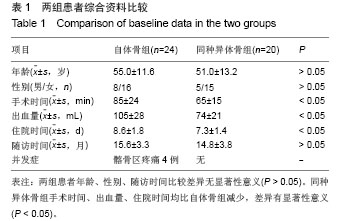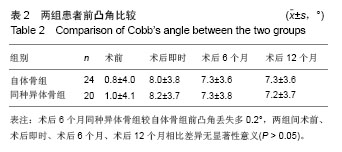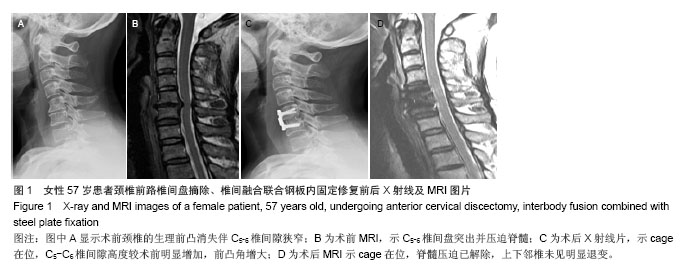| [1]Lin Q, Zhou X, Wang X, et al. A comparison of anterior cervical discectomy and corpectomy in patients with multilevel cervical spondylotic myelopathy. Eur Spine J. 2012;21(3): 474-481.
[2]Woods BI, Hohl J, Lee J, et al. Laminoplasty versus laminectomy and fusion for multilevel cervical spondylotic myelopathy. Clin Orthop Relat Res. 2011;469(3):688-695.
[3]Zimmermann G, Moghaddam A. Allograft bone matrix versus synthetic bone graft substitutes. Injury. 2011;42:S16-S21.
[4]Parish A, Hing K, Davis G. Quantifying structural quality of bone regeneration within a porous bone graft substitute. Bone Joint J Orthop Proc Suppl. 2014;96(Supp 11):319.
[5]Lad SP, Nathan JK, Boakye M. Trends in the use of bone morphogenetic protein as a substitute to autologous iliac crest bone grafting for spinal fusion procedures in the United States. Spine. 2011;36(4): E274-281.
[6]Skeppholm M, Olerud C. Pain from donor site after anterior cervical fusion with bone graft: a prospective randomized study with 12 months of follow-up. Eur Spine J. 2013;22(1): 142-147.
[7]Landriel FA, Hem S, Goldschmidt E, et al. Polyetheretherketone interbody cages versus autogenous iliac crest bone grafts with anterior fixation for cervical disc disease. J Spinal Dis Tech. 2013;26(2):61-67.
[8]Faldini C, Miscione MT, Acri F, et al. Single level cervical fusion by an anterior approach using autologous bone graft influences the adjacent levels degenerative changes: clinical and radiographic results at 10-year minimum follow-up. Eur Spine J. 2012;21(1):90-93.
[9]高顺红.同种异体骨移植的研究进展[J].中国矫形外科杂志, 2012,19(21):1797-1799.
[10]左健,康建敏,潘乐.同种异体骨移植用于骨缺损修复的应用现状[J].中国组织工程研究,2012,16(18):3395-3398.
[11]Froum SJ, Wallace S, Cho SC, et al. Histomorphometric Comparison of Different Concentrations of Recombinant Human Bone Morphogenetic Protein with Allogeneic Bone Compared to the Use of 100% Mineralized Cancellous Bone Allograft in Maxillary Sinus Grafting. Int J Periodontics Restorative Dent. 2012;33(6):721-730.
[12]Fretwurst T, Spanou A, Nelson K, et al. Comparison of four different allogeneic bone grafts for alveolar ridge reconstruction: a preliminary histologic and biochemical analysis. Oral Surg. 2014;118(4):424-431.
[13]Kang J, An H, Hilibrand A, et al. Grafton and local bone have comparable outcomes to iliac crest bone in instrumented single-level lumbar fusions. Spine. 2012; 37(12):1083-1091.
[14]Faldini C, Chehrassan M, Miscione MT, et al. Single-level anterior cervical discectomy and interbody fusion using PEEK anatomical cervical cage and allograft bone. J Orthop Traumatol. 2011;12(4):201-205.
[15]刘艺,李钦亮,陈鸣,等.同种异体骨在脊髓型颈椎病后路双开门椎管扩大植骨成形术中的应用[J].江苏医药,2010,36(16):1875-1877.
[16]施建党,王自立,王沛,等.同种异体骨与自体骨在颈椎结核植骨融合中的应用比较[J].中国修复重建外科杂志, 2011,25(11): 1290-1293.
[17]李翔,戴志唐,常新,等.颈椎前路手术对脊髓型颈椎病患者椎间盘组织中炎性细胞因子的影响[J].中华实验外科杂志, 2011, 28(11): 1988-1990.
[18]李云鹏,陈晓亮,马进峰,等.应用同种异体植骨融合术治疗脊髓型颈椎病的远期疗效[J].颈腰痛杂志, 2013,34(3):205-209.
[19]陈同磊,成茂华,沈忆新,等.自体骨或硫酸钙人工骨结合 MC+® 椎间融合器在颈椎前路融合中的应用:疗效及并发症比较[J]. 中国组织工程研究, 2010,14(4):718-721.
[20]Epstein NE. Iliac crest autograft versus alternative constructs for anterior cervical spine surgery: Pros, cons, and costs. Surg Neurol Int. 2012;3(Suppl 3):S143.
[21]Smith GW, Robinson RA. The treatment of certain cervical-spine disorders by anterior removal of the intervertebral disc and interbody fusion. J Bone Joint Surg. 1958;40(3):607-624.
[22]Cloward RB. The anterior approach for removal of ruptured cervical disks. J Neurosurg. 1958;15(6):602-617.
[23]Hinsenkamp M, Muylle L, Eastlund T, et al. Adverse reactions and events related to musculoskeletal allografts: reviewed by the World Health Organisation Project NOTIFY. Int Orthop. 2012; 36(3):633-641.
[24]Kang J, An H, Hilibrand A, et al. Grafton and local bone have comparable outcomes to iliac crest bone in instrumented single-level lumbar fusions. Spine. 2012;37(12):1083-1091.
[25]Kumaresan S, Yoganandan N, Pintar F A, et al. Contribution of disc degeneration to osteophyte formation in the cervical spine: a biomechanical investigation. J Orthop Res. 2001; 19(5):977-984.
[26]Lee FY, Hazan EJ, Gebhardt MC, et al. Experimental model for allograft incorporation and allograft fracture repair. J Orthop Res. 2000;18(2):303-306.
[27]黄长明,王臻.大段同种异体骨移植愈合的实验研究[J].骨与关节损伤杂志,2000,15(5):355-358.
[28]Lamb KE, Lodhi S, Meier-Kriesche HU. Long‐Term Renal Allograft Survival in the United States: A Critical Reappraisal. Am J Trans. 2011;11(3):450-462.
[29]Wood RA, Mealey BL. Histologic comparison of healing after tooth extraction with ridge preservation using mineralized versus demineralized freeze-dried bone allograft. J Periodontol. 2012;83(3):329-336.
[30]Miller LE, Block JE. Safety and effectiveness of bone allografts in anterior cervical discectomy and fusion surgery. Spine. 2011; 36(24): 2045-2050.
[31]Macdonald RL, Fehlings MG, Tator CH, et al. Multilevel anterior cervical corpectomy and fibular allograft fusion for cervical myelopathy. J Neurosurg. 1997;86(6):990-997.
[32]Yue WM, Brodner W, Highland TR. Long-term results after anterior cervical discectomy and fusion with allograft and plating: a 5-to 11-year radiologic and clinical follow-up study. Spine. 2005; 30(19):2138-2144.
[33]Rintala DH, Loubser PG, Castro J, et al. Chronic pain in a community-based sample of men with spinal cord injury: prevalence, severity, and relationship with impairment, disability, handicap, and subjective well-being. Arch Phys Med Rehabil. 1998;79(6):604-614.
[34]Hawker GA, Gignac MAM, Badley E, et al. A longitudinal study to explain the pain‐depression link in older adults with osteoarthritis. Arth Care Res. 2011;63(10):1382-1390.
[35]Rudy TE, Kerns RD, Turk DC. Chronic pain and depression: toward a cognitive-behavioral mediation model. Pain. 1988; 35(2):129-140.
[36]Latimer AE, Ginis KA, Hicks AL, et al. An examination of the mechanisms of exercise-induced change in psychological well-being among people with spinal cord injury. J Rehabil Res Dev. 2004;41(5):643-652.
[37]Dagci T, Armagan G, Konyalioglu S,et al. Alterations in the expression of the apurinic/apyrimidinic endonuclease-1/redox factor-1 (APE/ref-1) and DNA damage in the caudal region of acute and chronic spinal cord injured rats treated by embryonic neural stem cells. Phys Res. 2009;58(3):427-434.
[38]陈德强,张鹏.骨髓复合人工骨治疗骨折不愈合的临床观察[J]. 中国误诊学杂志, 2007,7(16):3741-3742.
[39]Bahney CS, Hu DP, Taylor AJ, et al. Stem Cell–Derived Endochondral Cartilage Stimulates Bone Healing by Tissue Transformation. J Bone Mineral Res. 2014;29(5):1269-1282.
[40]Behr B, Sorkin M, Lehnhardt M, et al. A comparative analysis of the osteogenic effects of BMP-2, FGF-2, and VEGFA in a calvarial defect model. Tissue Eng Part A. 2012;18(9-10): 1079-1086. |


